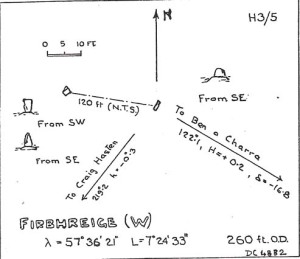Standing Stones: OS Grid Reference – NF 7700 7031
Also known as:
- Canmore ID 10079
- Toroghas
This is nice n’ far north indeed – north-west Uist in fact! Hit the A865 road northwest to the village of Ceann a’ Bhaigh. By the little church at the little crossroad, take the track on your right which leads you into the hills. Go all the way to the end of this track and walk straight north for a couple of hundred yards, as if you’re heading up the hill, Toroghas, in front of you.
Archaeology & History
Here are two small standing stones, each not much more than three-feet tall, about 40 yards apart. Alexander Thom (1984) looked for astronomical alignments here, but found very little, merely commenting: “From here a number of sites are visible, but the (easternmost) stone might be said to indicate Craig Hasten or Deaskeir Islet.” In his own analysis of the site, Clive Ruggles (UI23 – 1984) also found such astronomy lacking here.
Folklore
In Thom, Thom & Burl’s (1990) description of these two small stones, Aubrey Burl mentioned how “their name is similar to the stones on Skye called ‘Na Fir Bhreige’, or ‘the false men’. This has been variously interpreted as meaning men who were turned to stone for being unfaithful to their wives or, alternatively, to stones that from a distance resembled men.” Which is apparently the tale here. (see Grinsell 1976)
Comparative religious studies clearly indicate that legends of petrified beings are representative of the spirits of the ancestors residing in the said stones or other artifact. If there’s any validity to this ingredient, it would imply that some prehistoric burials can be found nearby — though my archaeo-records show nothing (but that doesn’t mean they’re not there). If there anyone goes wandering hereabouts in the near future, see if you can find any tombs in the locale.
References:
- Beveridge, Erskine, North Uist: Archaeology and Topography, William Brown: Edinburgh 1911.
- Ruggle, C.L.N., Megalithic Astronomy, BAR: Oxford 1984.
- Thom, A., Thom, A.S. & Burl, A., Stone Rows and Standing Stones, vol.1, BAR: Oxford 1990.
© Paul Bennett, The Northern Antiquarian
The map could not be loaded. Please contact the site owner.
